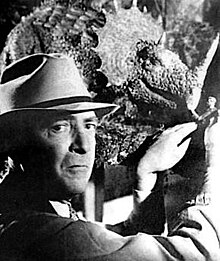Willis O'Brien
| Willis O'Brien | |
|---|---|

O'Brien on the set of Son of Kong.
|
|
| Born |
Willis Harold O'Brien March 2, 1886 Oakland, California, U.S. |
| Died | November 8, 1962 (aged 76) Los Angeles, California, U.S. |
| Resting place | Chapel of the Pines Crematory |
| Other names | Obie |
| Occupation | Stop motion model animator |
| Years active | 1915–1962 |
| Spouse(s) | Hazel Ruth Collette (1925–1930) (divorce) Darlyne Prenett (1933–1962) (his death) |
| Awards | Winsor McCay Award (1997) |
Willis Harold O'Brien (March 2, 1886 – November 8, 1962) was an American motion picture special effects and stop-motion animation pioneer, who according to ASIFA-Hollywood "was responsible for some of the best-known images in cinema history," and is best remembered for his work on The Lost World (1925), King Kong (1933) and Mighty Joe Young (1949), for which he won the 1950 Academy Award for Best Visual Effects.
Willis O'Brien was born in Oakland, California. He first left home at the age of eleven to work on cattle ranches, and again at the age of thirteen when he took on a variety of jobs including farmhand, factory worker, fur trapper, cowboy, and bartender. During this time he also competed in rodeos and developed an interest in dinosaurs while working as a guide to palaeontologists in Crater Lake region.
He spent his spare time sculpting and illustrating and his natural talent led to him being employed first as draftsman in an architect's office and then as a sports cartoonist for the San Francisco Daily News. During this time he also became a professional boxer, winning his first nine bouts but retiring after an unsuccessful tenth. He subsequently worked for the railroad, first as a brakeman and later a surveyor, as a professional marble sculptor, and was assistant to the head architect of the 1915 San Francisco World's Fair, where some of his work was displayed. During this time he made models, including a dinosaur and a caveman, which he animated with the assistance of a local newsreel cameraman. San Francisco exhibitor Herman Wobber saw this 90-second test footage and commissioned O'Brien to make his first film, The Dinosaur and the Missing Link: A Prehistoric Tragedy (1915) for a budget of $5,000.
Thomas Edison was impressed by the film and O'Brien was hired by the Edison Company to animate a series of short films with a prehistoric theme, these included R.F.D. 10,000 B.C. and Prehistoric Poultry (both 1917). During this time he also worked on other Edison Company productions including Sam Loyd's The Puzzling Billboard and Nippy's Nightmare (both 1917), which were the first stop-motion films to combine live actors with stop motion models. These films led to a commission from Herbert M. Dawley to write, direct, co-star and produce the effects for another dinosaur film, The Ghost of Slumber Mountain (1918), for a budget of $3,000. The collaboration was not a happy one and Dawley would cut the 45-minute film down to 11 minutes and claim credit for O'Brien's pioneering effects work, which combined realistic stop-motion animated prehistoric models with live action. The film grossed over $100,000 and Dawley used the cut effects footage in a sequel Along the Moonbeam Trail (1920) and the documentary Evolution (1923), but O'Brien received little financial reimbursement from this success.
...
Wikipedia
